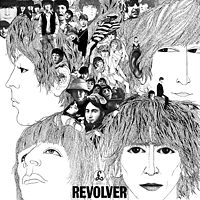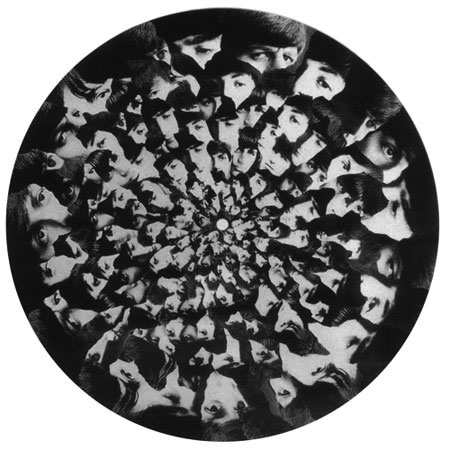Revolver
From Beatles Wiki - Interviews, Music, Beatles Quotes
| Revolver | |||||
 |
|||||
| Studio album by The Beatles | |||||
|---|---|---|---|---|---|
| Released | 5 August 1966 | ||||
| Recorded | 6 April – 21 June 1966 Abbey Road Studios, London |
||||
| Genre | Pop, Psychedelic Rock | ||||
| Length | 34:58 | ||||
| Label | Parlophone | ||||
| Producer | George Martin | ||||
| The Beatles chronology | |||||
|
|||||
| The Beatles American chronology | |||||
|
|||||
| Singles from Revolver | |||||
|
|||||
|
|||||
| “ | The group encouraged us to break the rules. [...] It was implanted when we started 'Revolver' that every instrument should sound unlike itself: a piano shouldn't sound like a piano, a guitar shouldn't sound like a guitar. There were lots of things I wanted to try, we were listening to American records and they sounded so different, the engineers [at Abbey Road] had been using the same [methods] for years and years. | „ |
|
—Geoff Emerick, The Beatles: 10 Years That Shook The World, Mojo , 2004 |
||
| “ | [The title] is just a name for an LP, and there's no meaning to it. Why does everyone want a reason every time you move? It means Revolver. It's all the things that Revolver means, because that's what it means to us, Revolver and all the things we could think of to go with it. | „ |
|
—John Lennon, 1966 |
||
| “ | Well, it just came about because we all sat round trying to think of a name and Paul thought of Revolver, and we hadn't thought of anything better, so we called it Revolver." And also, if you want to be clever, it also means revolving, because the record goes round. | „ |
|
—Ringo Starr, 1966 |
||
| “ | Rubber Soul was the pot album, and Revolver was acid. I mean, we weren't all stoned making Rubber Soul, because in those days we couldn't work on pot. | „ |
|
—John Lennon, 1966 |
||
| “ | The first thing that happened with with the new album was that Paul and I decided we'd have to get together. We'd been seein each other socially, but we decided we'd have to get down to some serious work. Getting down together is the first step, and it's not always the easiest. Then, when we've got together, either at my place or at Paul's home, we start thinking about the songs. One of us usually thinks of a musical phrase or part of a tune in our heads,like Paul did with 'Paperback Writer.' He thought that out in the car on his way to my house. | „ |
|
—John Lennon, 1966 |
||
| “ | Unlike our previous LPs, this one is intended to show our versatility rather than a haphazard collection of songs. We use trumpets, violins and cellos to achieve new effects. George has written three of the tracks. On past LPs he never did more than two and Ringo sings, or rather talks, a children's song. This is all part of our idea of being up-to-date and including something for everybody. We don't intend to go back and revive ideas of twenty years ago. | „ |
|
—Paul McCartney, 1966 |
||
| “ | We were going to record Revolver in America, but they wanted a fantastic amount of money to use the facilities there. [...] When we finished Revolver, we realised that we had found a new British sound almost by accident. I think there were only two tracks on the LP that would have sounded better if we'd cut them in America. 'Taxman' and 'Got To Get You Into My Life,' because they need that raw quality that you just can't get in this country for some reason. But 'Eleanor Rigby' would have been worse, because the string players in America aren't so good. | „ |
|
—Paul McCartney, 1966 |
||
| “ | John, Paul, and I devoted an evening to sifting through an enormous pile of newspapers and magazines for pictures of the Beatles after which we cut out the faces and glued them all together. Our handiwork was later superimposed onto (the) line drawing by Klaus Voormann, their old friend from Hamburg. | „ |
|
—Pete Shotton, In My Life, 1983 |
||
| “ | "The photo of Ringo with the funny striped shirt on, that was cut out of a magazine, from a picture of a girl who had that poster on her wall. That's why the picture is at a funny angle. I had a few strange ones where John was pulling a face, or Paul was laughing, but in general, the photos show their sweet side. [...] There was one picture where Paul was sitting on a toilet. I think that photo was taken in Hamburg. [...] I went to the EMI house, up to George Martin's office and I stood the artwork up on a filing cabinet. There was Brian Epstein, George Martin, his secretary and the four lads. I was scared, because nobody said anything. They were just looking at it. I thought, #@%!, they hate it. Then Paul looked closer and said, 'Hey that's me sitting on a toilet!' George Martin took a look and said, 'You can't show that!' Paul said, 'No, it's great!' But then he gave it some thought and said, 'Well, maybe we should take that one off..' So that broke the ice. Then they started talking about it. Everybody loved it, George loved it, John loved it, Ringo loved it. I looked at Brian, who was standing in the corner and he was crying... I thought, Oh no... what is he doing? He came up to me and said, 'Klaus, this is exactly what we needed. I was worried that this whole thing might not work, but I know now that this the cover. This LP, will work — thank you. | „ |
|
—Klaus Voorman, 19__ |
||
| The Beatles "Revolver" Press Conference — Los Angeles, August 27, 1966 | |
|
After several days of relaxing in LA, hanging out with the Byrds (that's David Crosby standing in the back between Paul and George) and others, the Beatles, prior to their Dodger Stadium show, give a press conference where they discuss Revolver (Just Eleanor Rigby and Tomorrow Never Knows), the "We're more popular than Jesus" controversy, and other stuff. Lennon is clearly a bit testy and impatient while Paul, as always, plays the nice guy... |
|
